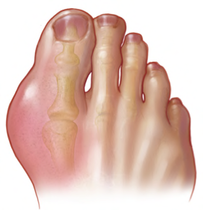 Gout’s Resurgence Author: Lindsay Getz The increase in the number of people experiencing gout creates good reason to become educated on this troublesome disease. While many people have heard of gout, the idea that it’s a ‘disease of the past’ has made it one of those ailments about which most know very little. But older adults who suffer from this excruciating form of inflammatory arthritis know it’s a condition that warrants attention. In fact, gout has made a massive resurgence, and some studies even suggest the number of cases in this country has doubled in the last three decades. Once called the disease of kings because of its association with living the high life, gout, as doctors know, can strike anyone, though it’s thee to four times as common in men as in women. And there are certainly factors that put some at higher risk than others. While we know that it’s not just a rich man’s disease, it’s easy to understand the origin of this former belief. Modern research has demonstrated that overconsumption of luxury foods such as red meat, shellfish, hard liquor and beer may increase the risk of a gout attack. The reason is that these foods are rich in purines, chemical components that eventually become uric acid and, in cases of excess, can metabolise into crystal that settle into the joints and cause great pain. In addition to being linked with eating purine-rich foods, gout is also associated with obesity in general, as well as with conditions such as diabetes, hypertension and heart disease – all of which seem to be on the rise globally. There’s even been studies that show a high incidence of people who drink sugary beverages. A study found men who consume at least two soft drinks per day had an 85 percent greater likelihood of developing gout than those who drank less than one per month. In fact, even at lower levels, soda consumption increased the risk of gout in study participants. Another potential cause of gout is kidney malfunction, which can result in a build up of uric acid. And, like most diseases, there can be a genetic component. In fact one in four gout sufferers have a family history of it. Gout, may in fact, be entirely hereditary, so it’s important that those with a family history of gout go out of their way to avoid foods that are high in purines and live a healthy lifestyle. While genetics have left some people predisposed to developing the disease, the resurgence of gout is likely linked to the way westerners live today. There is a lot of speculation that the rising number of gout cases may correlate with the obesity epidemic. It also happens to be a disease that affects older adults. Because it occurs in the ageing population, as more New Zealanders get older, it makes sense we're seeing more cases surface.  When gout strikes Gout is most commonly known for causing sudden pain and swelling in the big toe. While that’s not the only place it can strike, about 90 percent of gout sufferers will at some point experience such pain and swelling in the big toe. Gout can actually affect a number of joints, including the knees, elbows, wrists and those of the hands and feet. Symptoms include swelling and redness around the affected joint, sudden and severe pain, limited movement in the affected joint, and in some cases, a fever. In addition, as the crystals accumulate with joints, they can form tophi or chalk like lumps and bumps that can actually become deforming over time. Once the gout attack subsides, it’s also possible the skin around the joint to peel. An initial gout attack may last anywhere from three to 10 days. While it may not always be possible to prevent gout, especially when it’s hereditary, there are ways to decrease the likelihood of an attack. According to Naomi Schlesinger, MD, chief of the division of rheumatology at the University of Medicine and Dentistry of New Jersey, losing weight or maintaining a healthy weight, eating a diet low in purine-rich foods and fructose and treating underlying conditions such as hypertension and diabetes are effective preventative measures. The emergence of a gout attack has also been associated with cold temperatures. This may be one reason why it occurs in the joints of the big toe, which are the farthest away from the centre of the body. Classically, an attack of gout comes on at night. Gout sufferers often describe episodes of waking up in the middle of the night with cold feet and a tremendous amount of pain in the big toe. It’s not proven as an effective preventative measure, but it can’t hurt to try and keep your feet warm during the night, perhaps sleeping with a pair of socks on. Keeping gout at bay Besides making lifestyle changes to control gout, certain medications can ease the pain and help prevent future attacks. Nonsteroidal anti-inflammatory drugs, colchicine and steroids, have all long been used for gout treatment. However the rapid reappearance of this disease has prompted many drug companies to scramble to improve on old treatments with stronger and more effective drugs. As researchers continue to make advances toward better gout treatment, one of the most important roles that professionals can take for their patients is that of an educator. Since gout is not a disease of the past and is actually a very real modern-day concern, it will help to empower patients with vital information. But first, it’s imperative to be self-educated. It’s important that individuals in positions to recognise the symptoms of gout, including those in various facets of the medical field, in social work positions, or involved with geriatric care, become more familiar with the disease. Education is definitely important in making the right diagnosis and knowing the different treatment options available today. Becoming educated can help carers better care for their patients by recognising the symptoms early and helping prevent future attacks. The prevention of gout dovetails nicely with the prevention of many other chronic medical problems that are known to affect the ageing population – obesity, cardiovascular disease, and diabetes, in particular. It really comes down to weight control, balanced diet and activity levels; these are three areas that should already be focused on to prevent other medical conditions in older adults. It’s interesting that the rise of gout has paralleled the risk of these other chronic diseases within our society and it’s easy to link them all to being inactive, overweight and making bad food choices. It’s important for people to recognise that a lot of these chronic medical conditions really have the same common genesis and require making the same lifestyle changes for better health. Author: Lindsay Getz Aged Care Issue 2 2021 If you need help to reduce purine in your diet
our friendly Dietitians can help just contact Therapy Professionals Ltd Ph: 03 377 5280 Email: [email protected] Comments are closed.
|
AuthorShonagh O'Hagan Archives
July 2024
|

 RSS Feed
RSS Feed